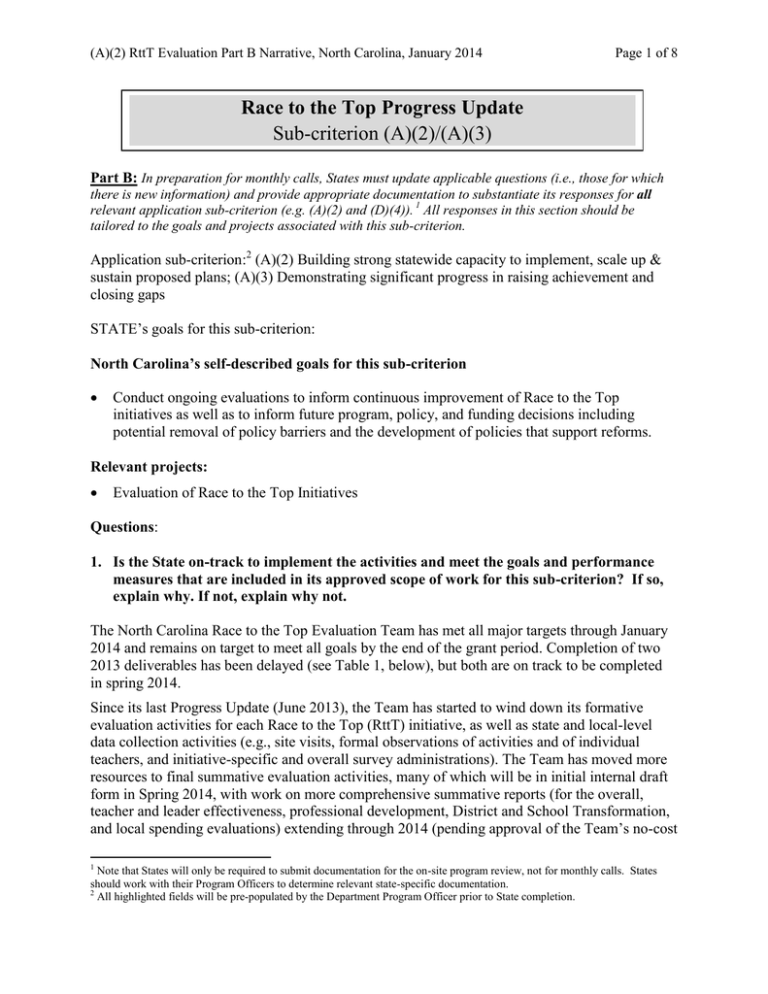Race to the Top Progress Update Sub-criterion (A)(2)/(A)(3) Part B:
advertisement

(A)(2) RttT Evaluation Part B Narrative, North Carolina, January 2014 Page 1 of 8 Race to the Top Progress Update Sub-criterion (A)(2)/(A)(3) Part B: In preparation for monthly calls, States must update applicable questions (i.e., those for which there is new information) and provide appropriate documentation to substantiate its responses for all relevant application sub-criterion (e.g. (A)(2) and (D)(4)). 1 All responses in this section should be tailored to the goals and projects associated with this sub-criterion. Application sub-criterion:2 (A)(2) Building strong statewide capacity to implement, scale up & sustain proposed plans; (A)(3) Demonstrating significant progress in raising achievement and closing gaps STATE’s goals for this sub-criterion: North Carolina’s self-described goals for this sub-criterion Conduct ongoing evaluations to inform continuous improvement of Race to the Top initiatives as well as to inform future program, policy, and funding decisions including potential removal of policy barriers and the development of policies that support reforms. Relevant projects: Evaluation of Race to the Top Initiatives Questions: 1. Is the State on-track to implement the activities and meet the goals and performance measures that are included in its approved scope of work for this sub-criterion? If so, explain why. If not, explain why not. The North Carolina Race to the Top Evaluation Team has met all major targets through January 2014 and remains on target to meet all goals by the end of the grant period. Completion of two 2013 deliverables has been delayed (see Table 1, below), but both are on track to be completed in spring 2014. Since its last Progress Update (June 2013), the Team has started to wind down its formative evaluation activities for each Race to the Top (RttT) initiative, as well as state and local-level data collection activities (e.g., site visits, formal observations of activities and of individual teachers, and initiative-specific and overall survey administrations). The Team has moved more resources to final summative evaluation activities, many of which will be in initial internal draft form in Spring 2014, with work on more comprehensive summative reports (for the overall, teacher and leader effectiveness, professional development, District and School Transformation, and local spending evaluations) extending through 2014 (pending approval of the Team’s no-cost 1 Note that States will only be required to submit documentation for the on-site program review, not for monthly calls. States should work with their Program Officers to determine relevant state-specific documentation. 2 All highlighted fields will be pre-populated by the Department Program Officer prior to State completion. (A)(2) RttT Evaluation Part B Narrative, North Carolina, January 2014 Page 2 of 8 extension request; see below), per the Evaluation work plan that is updated and submitted monthly. In addition, the Team continues to improve its data collection procedures to better meet the goals of this sub-criterion. Revised data collection procedures include improvements in the approach to collecting responses from educators from across the state for the Team’s fourth and final statewide survey of a representative sample of schools (with 365 schools again expected to participate this spring). Most important for participating schools will be the Team’s implementation of a streamlined process for establishing school-level participant rosters that not only will reduce administrative burdens on schools but also will improve data quality. By the end of this final administration, the data from the survey—which already supports several initiative-level evaluations (e.g., the Teacher and Leader Effectiveness evaluation, the District and School Transformation evaluation, the Professional Development Initiative evaluation, etc.)—will provide critical information for the final series of reports that will address the overall impact of the RttT initiatives. The Team also continues to maintain an online database for tracking interactions with schools and LEAs (in an effort to minimize the evaluation burden placed on any given school or LEA).3 Finally, in addition to the 23 scheduled reports already submitted to the North Carolina Department of Public Instruction (NCDPI) before the previous review in Summer 2013, the Team has submitted thirteen more reports (Table 1, following pages), all of which have been shared with stakeholder groups, and nine of which have been approved and finalized. To date (January 2014), the Evaluation Team has finalized 32 reports, four are under review at DPI, and one more is to be submitted to DPI for review by early March. The Team is on schedule to complete an additional 16 reports4 by the end of the RttT period. All finalized reports continue to be made available on the Team’s website.5 Of particular note, one deliverable that experienced multiple delays in finalization in 2012 and early 2013—the baseline study of the statewide distribution of teacher quality—now is complete and available publicly.6 The baseline it established will serve as an important component of the series of final evaluation reports. 3 https://s3.amazonaws.com/evaluation.tools/evaluationdb/index.html; please be aware that there is an occasional delay when the page initially loads; the Team also continues to update and maintains a dynamic list of contacts for each LEA and school, which is accessible to all Evaluation Team members: https://s3.amazonaws.com/evaluation.tools/contactsdb/index.html 4 Listed at: http://cerenc.org/rttt-evaluation/executive-summaries/ 5 http://cerenc.org 6 http://cerenc.org/wp-content/uploads/2013/12/Baseline-TQ-Report_FINAL_12-05-2013.pdf (A)(2) RttT Evaluation Part B Narrative, North Carolina, January 2014 Page 3 of 8 Table 1. Submitted North Carolina Race to the Top Evaluation Reports (as of January 2014) North Carolina Teacher Corps Supply and Distribution of Teachers and Leaders Strategic Staffing Regional Leadership Academies Teacher Quality Incentives Distribution Effective Teachers and Leaders Report Title Teacher and Leader Evaluation Evaluation Strand Comparing Value Added Models for Estimating Teacher Effectiveness: Technical Briefing Comparing Value-Added Models for Estimating Individual Teacher Effects on a Statewide Basis: Simulation and Empirical Analyses Release Date Available at: February 2012 http://cerenc.org/wpcontent/uploads/2011/1 0/EE_VAM_Briefing_2 -7-12.pdf October 2012 http://cerenc.org/wpcontent/uploads/2011/1 0/FullVAM_report_FINAL_8 -27-12.pdf Measures of Student Growth in the North Carolina Educator Evaluation System: Formative Evaluation Report September 2013 Teacher Performance Incentives in North Carolina September 2013 The Distribution of Effective Teachers in North Carolina December 2013 Regional Leadership Academies: Cost-Effectiveness Framework North Carolina Regional Leadership Academies: Final 2012 Activity Report North Carolina Regional Leadership Academies: Final 2013 Activity Report March 2012 March 2013 February 2014 (Anticipated) Local Strategic Staffing in North Carolina: A Review of Plans and Early Implementation September 2012 State Strategic Staffing: Recruitment Incentive for Lowest-Performing Schools September 2013 North Carolina Teacher Corps Start-Up and Teach for America Expansion: Initial Findings on Recruitment, Training, and Placement North Carolina Teacher Corps: Year One Implementation Report http://cerenc.org/wpcontent/uploads/2011/1 0/FINAL-Formativereport-TLEE-measuresof-student-growth-9-x13.pdf http://cerenc.org/wpcontent/uploads/2011/1 0/FINAL-BonusIncentive-ProgramReport-8-29-13.pdf http://cerenc.org/wpcontent/uploads/2013/1 2/Baseline-TQReport_FINAL_12-052013.pdf http://cerenc.org/wpcontent/uploads/2011/1 0/RLA_cost_effectiven ess_framework_3-112.pdf http://cerenc.org/wpcontent/uploads/2011/1 0/RLA_First-YearReport-03-04-13.pdf http://cerenc.org/wpcontent/uploads/2011/1 0/Strategicstaffing_1stYearReport_-FINAL-09-242012.pdf http://cerenc.org/wpcontent/uploads/2011/1 0/FINAL-StateStrategic-Staffing-8-2913.pdf October 2012 http://cerenc.org/wpcontent/uploads/2011/1 0/NCTC_PreliminaryR eport_10-29-2012.pdf November 2013 http://cerenc.org/wpcontent/uploads/2011/1 0/FINAL_NCTC_Seco nd-Annual-Report_1107-2013.pdf Supply and Distribution of Teachers and Leaders (cont.) Release Date Available at: New Teacher Support Program Evaluation Strand Report Title Page 4 of 8 North Carolina New Teacher Support Program: First Annual Race to the Top Evaluation Report April 2013 http://cerenc.org/wpcontent/uploads/2013/0 4/NTSP-First-YearReport-FINAL.pdf North Carolina New Teacher Support Program: Interim Evaluation Report March 2014 (Anticipated)^ NC Virtual Public School Blended STEM Courses (A)(2) RttT Evaluation Part B Narrative, North Carolina, January 2014 North Carolina Virtual Public School Blended Learning STEM Courses: A Formative Assessment of Initial Implementation, Part I North Carolina Virtual Public School Blended Learning STEM Courses: A Formative Assessment of Initial Implementation, Part II Prospects for Using Digital Recording Systems for Evaluation: An Overview April 2013 Oct-13 October 2011 http://cerenc.org/wpcontent/uploads/2011/1 0/NCVPS-blendedcourseimpact_FINAL.pdf http://cerenc.org/wpcontent/uploads/2011/1 0/NCVPS-blendedcourse-impact_Spring2013-follow-upreport_FINAL-10-042013.pdf http://cerenc.org/wpcontent/uploads/2011/1 1/Report_ClassroomObservation-CameraTechnology_10-312011.pdf First Annual Race to the Top Professional Development Evaluation Report (in Three Parts): A. Building LEA and Regional Professional Development Capacity: First Annual Evaluation Report Professional Development B. Distinguished Leadership in Practice (DLP): First Annual RttT Evaluation Report C. Race to the Top Online Professional Development Evaluation: Year 1 Report January 2012 http://cerenc.org/wpcontent/uploads/2012/0 1/PD_1st_Year_Report _1-5-121.pdf September 2012 http://cerenc.org/wpcontent/uploads/2011/1 1/NC-RttT_TDLPReport_-9-3-12.pdf November 2012 http://cerenc.org/wpcontent/uploads/2011/1 1/OPD_Y1_FINAL_11 _9_12.pdf Second Annual Race to the Top Professional Development Evaluation Report (in Two Parts): A. Statewide Face-to-Face Professional Development Formative Evaluation March 2013 B. Local Outcomes Baseline Study March 2013 http://cerenc.org/wpcontent/uploads/2011/1 1/2nd-Annual-PDReport_statewide_0201-13.pdf http://cerenc.org/wpcontent/uploads/2011/1 1/2nd-Annual-PDReport_localoutcomes_02-01-13.pdf (A)(2) RttT Evaluation Part B Narrative, North Carolina, January 2014 Evaluation Strand Report Title Release Date Page 5 of 8 Available at: Third Annual Race to the Top Professional Development Evaluation Report (in Two Parts): Professional Development (cont.) A. Distinguished Leadership in Practice (DLP): Second annual Evaluation Report B. Third Annual Race to the Top Professional Development Evaluation Report Turning Around LowestAchieving Schools Turning Around North Carolina’s Lowest Achieving Schools (2006-2010) STEM Anchor and Affinity Schools District and School Transformation Local Spending Productive Connections: Intervention in Low Performing School Districts by the NCDPI District and School Transformation Division, 2011-12 Initial Findings on the School Leader Professional Development Series Turning Around North Carolina's Lowest Achieving Schools: Third Annual Report North Carolina’s STEM High Schools: An Overview of Current Data STEM Affinity Networks: Year 1 Report STEM Affinity Network: Second-Year Report November 2013 http://cerenc.org/wpcontent/uploads/2011/1 1/FINAL_DLP-201213-Evaluation-Report11-7-13.pdf February 2014 (Anticipated) September 2011 http://cerenc.org/wpcontent/uploads/2011/1 1/DST_1st-yearReport_FINAL_12-052011.pdf April 2013 http://cerenc.org/wpcontent/uploads/2013/0 4/DST-District-LevelReport-Y2-FINAL.pdf April 2013 http://cerenc.org/wpcontent/uploads/2013/0 4/DST-PD-FINAL.pdf May 2014 (Delayed; Revised Anticipated Date)* December 2011 April 2012 November 2012 STEM Affinity Network: Year 3 Report December 2013 Local Education Agency Race to the Top Expenditures: An Initial Analysis September 2012 Local Education Agency Race to the Top Expenditures: An Analysis of Fund Use and Expenditure Patterns June 2013 http://cerenc.org/wpcontent/uploads/2011/1 1/STEM_BaselineReport_11-02-2011.pdf http://cerenc.org/wpcontent/uploads/2012/0 4/STEM_Affinity_Net works_Year_1_report__4_4_12.pdf http://cerenc.org/wpcontent/uploads/2011/1 1/STEM_SecondYear_Report_FINAL_1 1_13_12.pdf http://cerenc.org/wpcontent/uploads/2013/1 2/RttT-STEM_Y3Report_FINAL_12-052013.pdf http://cerenc.org/wpcontent/uploads/2011/1 1/NC-RttT_Localspending-baseline_9-412.pdf http://cerenc.org/wpcontent/uploads/2011/1 1/LocalSpending_Y2_05-2913_Full-Report.pdf (A)(2) RttT Evaluation Part B Narrative, North Carolina, January 2014 Evaluation Strand Report Title Summary: Formative Assessments of Promising Practices, 2010-2012 Overall Evaluation Release Date March 2013 North Carolina’s Race to the Top Initiative: An Evaluation Update November 2013 A Preliminary Cost-Effectiveness Analysis of North Carolina’s Race to the Top Initiatives: Race to the Top Formative Evaluation Report April 2014 (Delayed; Revised Anticipated Date)* Page 6 of 8 Available at: http://cerenc.org/wpcontent/uploads/2013/0 2/RttT-OverallFormativeSummaryMemo_02-01-13.pdf http://cerenc.org/wpcontent/uploads/2013/0 2/Fall-2013-summaryof-RttT-evaluation-116-13.pdf ^NTSP: Due date for this second report (August 2013) was extended after delays in finalization of the first report prevented completion of the second report by the original due date. *DST: Initial draft anticipated for February 2014; Cost-Effectiveness: Initial draft anticipated for January 2014. 2. Does the State have evidence indicating the quality of implementation for this subcriterion? What is/has the State doing/done as a result of this information? To ensure timely completion of all evaluation tasks, the state continues to rely on a monitoring system that includes bi-weekly meetings with the Evaluation Team’s Steering Committee, a monthly report from the Evaluation Team on its progress toward meeting all activities described in the Scope of Work, and regular contacts among various RttT managers, initiative implementers, and evaluators. These contacts are characterized by a regular flow of information from the implementers about their programs and from the evaluators about evaluation progress and informal findings, as well as cross-organizational collaborations, when appropriate. As noted in previous reports, since fall 2012, the Evaluation Team has made significant changes to this communications flow to ensure greater awareness on the part of all stakeholders by expanding the list of contacts who are included in both formal and informal information exchanges about each initiative’s evaluation activities and processes. In addition, as noted above, the Evaluation Team continues to follow closely its four-year plan for providing formal, periodic reports of formative and summative evaluation results, both at the individual initiative level and at the overall RttT program level. Each report continues to go through a series of reviews and revisions at various levels of leadership at NCDPI before transmission to the final reviewing entity, the State Board of Education, to ensure that it is of the highest quality before release. Once reports are finalized, they continue to be posted on a public website7 that also includes information about planned content and expected completion dates for all remaining reports; a link on the NCDPI website8 also directs readers to this page. The Team continues to add one-paragraph summaries and separate executive summary documents for every finalized report, as well as a separate page9 with a full list of all completed and upcoming reports (also with links to executive summaries and full reports), to facilitate distribution of all findings to a wider array of stakeholders. 7 http://cerenc.org/ http://www.ncpublicschools.org/rttt/reports/ 9 http://cerenc.org/rttt-evaluation/executive-summaries/ 8 (A)(2) RttT Evaluation Part B Narrative, North Carolina, January 2014 Page 7 of 8 To continue to fulfill the Team’s obligation to share RttT-related findings and to ensure that those findings are thoroughly vetted, the Evaluation Team, NCDPI, and other initiative implementers continue to work together not only to maximize the impact the reports have on initiative implementation, but also to ensure those findings are shared with the State Board of Education and the North Carolina General Assembly. For example, as in the prior year, the Evaluation Team presented a summary of all findings to date to the State Board of Education in November 2013. At that same meeting, the Team worked with implementers of the RttT-funded Regional Leadership Academies to prepare a presentation for the Board that paired updates on implementation with findings from the most recent evaluation report. Also in November, Team members followed up on an April 2013 meeting with interested legislators (co-hosted by the General Assembly’s Research division) about local-level RttT-funded strategic staffing initiatives across the state by holding a second meeting for additional legislators. The Team is scheduled to present several more reports to the State Board throughout the spring of 2014. 3. What obstacles and/or risks could impact the State’s ability to meet its goals and performance measures related to this sub-criterion? The state remains on track to meet all goals associated with the RttT evaluation by the dates indicated in the current scope of work. However, approval of the state’s bid for a no-cost extension through June 2015 would allow the Evaluation Team to extend completion of the larger impact evaluations in order to include student achievement data—an important primary outcome metric—from the 2013-14 school year. These include the impact evaluations of changes to educator evaluation standards, the New Teacher Support Program, the state’s professional development initiatives, efforts to turn around low-achieving schools, final assessments of local spending, and overall impact of the RttT grant. As always, timely and thorough completion of evaluation goals and performance measures are dependent upon the implementation schedules for the RttT initiatives being evaluated. It is important to continue to bear in mind that, on the current deliverables schedule, evaluation activities for initiatives whose expected full implementation was extended to Y3 (2012-13) or Y4 (2013-14) will be limited due to the availability of, at most, one year of student outcome data, though a no-cost extension could help to alleviate this limitation to some extent. The Team is aware that it will need to continue to be flexible in its timelines over the closing months of the grant, to ensure that the most up-to-date data are included in summative evaluations. By the same token, the Team will benefit from ongoing support from NCDPI and the other implementers with respect to providing the Team with essential data as quickly as possible—particularly student outcomes data—as well as concordance tables that align current test items and results under the state’s new standards with items and results related to the previous standards Evaluation: Based on the responses to the previous question, evaluate the State’s performance and progress to date for this sub-criterion (choose one) Red (1) 10 Orange (2) Yellow (3) Green (4)10 Red – substantially off-track and/or has significant quality concerns; urgent and decisive action is required; Orange –off-track and/or there are quality concerns; many aspects require significant attention; Yellow –generally on-track and of high or good quality; only a few aspects require additional attention; Green – on-track with high quality. (A)(2) RttT Evaluation Part B Narrative, North Carolina, January 2014 Page 8 of 8 Paperwork Reduction Act Statement According to the Paperwork Reduction Act of 1995, no persons are required to respond to a collection of information unless such collection displays a valid OMB control number. Public reporting burden for this collection of information is estimated to average 74 hours (annually) per response, including time for reviewing instructions, searching existing data sources, gathering and maintaining the data needed, and completing and reviewing the collection of information. The obligation to respond to this collection is required to obtain or retain benefit (34 CFR 75.720, 75.730-732; 34 CFR 80.40 and 80.41). Send comments regarding the burden estimate or any other aspect of this collection of information, including suggestions for reducing this burden, to the U.S. Department of Education, 400 Maryland Ave., SW, Washington, DC 20210-4537 or email ICDocketMgr@ed.gov and reference the OMB Control Number 1894-0011.




